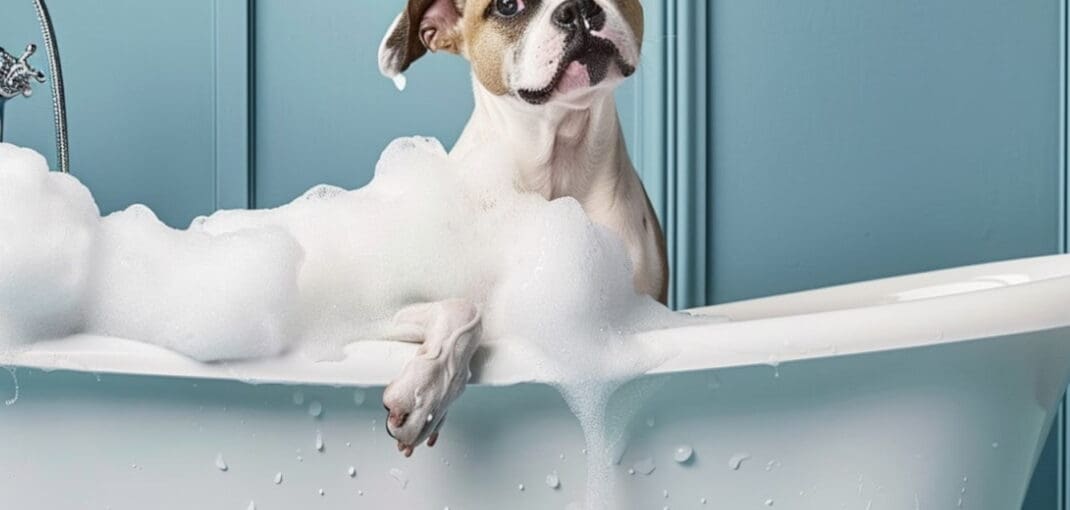Bathing your dog may seem like a simple task, but every pet owner knows that it is an activity that requires the right knowledge and preparation. Below is a comprehensive guide on how to bathe your dog to make the process both safe and comfortable for your pet.
Bathing your dog – how do you prepare? Familiarising your dog with water
How do I prepare my dog for a bath? Before bathing, it is important to prepare your dog properly. Starting at a young age, gradually familiarise your dog with water to avoid stress during washing. Start by gently spraying his paws during hot weather or playing in shallow water. By introducing water as part of play, you help your dog build positive associations.
Provide a warm and calm bathing area where your dog won’t be slipping and the water temperature is just right – neither too warm nor too cold. Before bathing, make sure to comb your dog’s coat thoroughly, especially if it is a long-haired breed. Use the right accessories like a dog brush to do this, which will help to remove tangled tufts and dirt.
How do you keep your dog calm while bathing? Keeping your dog calm is key to making washing a pleasure for both parties. You can use special bath toys or give natural dog treats to distract your dog and reward him for calm behaviour. Gentle talking and stroking will also help to calm the animal.
How often should my dog be bathed? Recommendations for different breeds
How often should my dog be washed? The frequency of bathing depends on a number of factors, including your dog’s coat type and lifestyle. How often should a puppy dog be bathed, and how often should an adult pet be bathed? The rules vary:
bathing a dog with short hair (such as Beagle, Boxer) – once every 2-3 months,
bathing a dog with medium hair (such as Border Collie) – every 4-6 weeks,
bathing a dog with long hair (such as Yorkshire Terrier, Shih Tzu) – every 3-4 weeks to avoid knots.
Puppies of all breeds – once every 4-6 weeks
For dogs living indoors that rarely get dirty outside, the frequency of bathing can be lower. However, it is worth bearing in mind that washing your dog too often can lead to dry skin and coat.
How often can a dog be bathed? For dogs that need regular bathing due to allergies or dermatological health requirements, it is advisable to consult your vet to adjust the frequency and type of cosmetics used.
Choosing a shampoo for your dog: what to look out for?
When choosing a shampoo, it must be tailored to your dog’s coat type and skin needs. There are dog shampoos and conditioners on the market that offer a variety of formulations:
For dogs with sensitive skin – hypoallergenic shampoos,
For dogs that play outside – shampoos with insect repellent additives,
For dogs with dry and flaky skin – moisturising shampoos with added oils.
The best shampoos for dogs are those that are tailored to their needs and coat type. When choosing a product, it is worth paying attention not only to the composition, but also to the pH of the shampoo, which should be adjusted to the pH of the dog’s skin. Products designed for humans, with too aggressive an action, can seriously damage the dog’s natural skin barrier.
How to bathe your dog? Step by step guide
Bathing your dog is not only a hygienic necessity, but also an important part of grooming that affects the health of our four-legged friend’s skin and coat condition. Below you will find a detailed guide on how to bathe your dog to make it a pleasure for both you and your pet.
Bathing your dog for the first time can be stressful no matter their age, so it’s worth preparing well. Before you start washing your dog, make sure you have everything you need on hand. To bathe your dog you will need:
the right shampoo for your dog,
towels,
a brush,
a hair dryer (optional),
treats as a reward.
So how do you wash your dog? The first step is to comb your dog’s coat thoroughly. Removing tangled hair and dirt will make further washing easier and help avoid matting the hair when exposed to water.
Wetting the coat – use warm (not hot) water to wet your dog’s coat evenly, avoiding the ears and eyes. The water should be pleasant to the touch so as not to frighten your pet.
Apply shampoo – apply shampoo specifically designed for dogs, gently massaging its skin and coat. A dog shampoo is essential as human products can harm the pH of your dog’s skin.
Rinsing – rinse the shampoo thoroughly with warm water, making sure that no cosmetic residue remains that could irritate your dog’s skin.
Drying – gently pat your dog dry with a towel, then use a hairdryer set on a cool setting, keeping it at a safe distance. Remember not to use hot air, which can burn your dog’s delicate skin.
How do you dry your dog after a bath? Proper drying is just as important as the bath itself. Leaving your dog with a wet coat, especially in cold weather, can lead to colds or the development of skin infections. Use a towel to gently squeeze out excess water and then a hairdryer on a cool setting to help your dog dry quickly.
Your dog is afraid of bathing – what should you do? Fear of water is a fairly common problem among dogs. To help your pet overcome the fear of bathing:
Start with small steps – get your dog used to water gradually, using rewards and positive reinforcement.
Use treats – while bathing, reward your dog with treats so that he associates water with something pleasant.
Create a friendly environment – provide warm water and a comfortable environment, avoiding loud and sudden noises.
Contraindications to washing: when not to bathe a dog?
Not every moment is right for bathing your dog. Here are situations when you should postpone washing your dog:
Illness – do not bathe your dog if he is ill or weakened. Bathing could put additional strain on his body.
Cold weather – avoid bathing on very cold days unless you can quickly and completely dry your dog’s coat.
Just after eating – bathing immediately after a meal can cause your dog discomfort or even lead to stomach turning, especially in large breeds.
By using dedicated cosmetics like professional dog skin care products, you can provide the best possible care for your four-legged friend’s skin and coat, making every bath safe and enjoyable. Remember, proper dog grooming after bathing, including thorough drying, is key to maintaining your dog’s health and hygiene.
Knowing how to bathe your dog is extremely important. Bathing not only cleans the coat, but can also be a great time to strengthen the bond between you and your dog. Regular bathing helps maintain your dog’s health, allows for earlier detection of skin problems and provides an overall sense of comfort and well-being for your pet.






